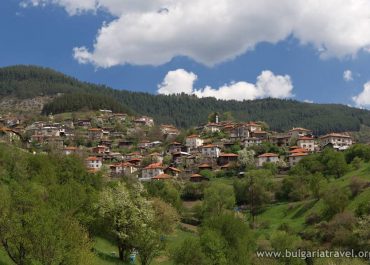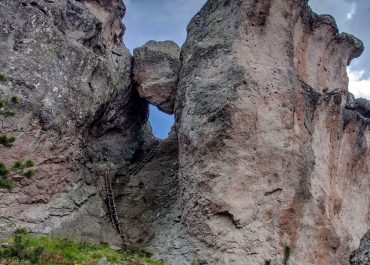
Museum of the Rhodopean Karst – Chepelare
The museum of the Rhodopean Karst in Chepelare exists since 1980. This is the only museum of this kind on the Balkan Peninsula.
The exposition begins with the Geology section. Beautiful minerals typical for the caves are shown in a number of windows. A part of the collection consists of minerals that can be found on the surface of the earth, but they are very typical for the Rhodope region – agate, corundum and other precious stones and semiprecious stones.
The development of the caving in Bulgaria can be traced in the hall dedicated to the 80th anniversary of the caving in Bulgaria. The collection also includes a unique Petromaks lamp which belonged to Ivan Buresh (1885 – 1980) – a zoologist and entomologist, who first in Bulgaria started examining the cave inhabitants and found new species for the science.
The spelaeology museum possesses a rich collection of various types of rock and cave formations.
The bio-spelaeology and cave paleontology sections are two of the most interesting sections for the visitors. Animal species that live in the caves are presented in the bio-spelaeology section. For the Bulgarian caves, these are spineless animals – spiders, grasshoppers, small crabs, centipedes, beetles. One of the most interesting species is the beetle Svetlomrazets (Light Hater), which dies when exposed to light.
The animals which have inhabited the caves are presented in the paleontology exposition. Many bones of cave bear are found in the Rhodopean caves. The visitors of the Paleontology Museum can see an entirely restored skeleton of a cave bear. The bear was a massive mammal that could reach up to 4.5 meters when standing on its back feet. The animal had vanished after the Last Glacial Period on Earth. Another peculiar detail which the visitors will learn is that the caves in the region were also inhabited by cave leopards in the past. In the museum, you can see a part of the lower jaw of a leopard, which is the oldest bone of such an animal, found in entire Europe. In the museum there are also remains of rhinoceros, which thousands of years ago had inhabited the territory of contemporary Bulgaria.
The last collection in the museum is dedicated to the people who had inhabited the caves thousands of years ago. Most of the oldest exponents in the museum are from the Yagodinska cave and are 6000 years old.
Information materials and postcards can be bought in the museum.
Monday – Saturday: 09.00 – 12.00; 13:30 – 17:30
7 A, Shina Andreeva Str.
Tel: +359 3051 30 41
The museum is attended by curators. Guided tours are offered in Bulgarian language, and audio records of tours are offered in English, French and German language.
Tourist information center – Chepelare
Monday – Friday: 8:30 – 17:30
1 A, Dicho Petrov Str., town of Chepelare, 4850
Tel:
+359 3051 81-78
+359 882 362 547
E-mail: tic@chepelare.bg
Website: https://visitchepelare.bg/en/
The museum of the Rhodopean Karst in Chepelare exists since 1980. This is the only museum of this kind on the Balkan Peninsula.
The exposition begins with the Geology section. Beautiful minerals typical for the caves are shown in a number of windows. A part of the collection consists of minerals that can be found on the surface of the earth, but they are very typical for the Rhodope region – agate, corundum and other precious stones and semiprecious stones.
The development of the caving in Bulgaria can be traced in the hall dedicated to the 80th anniversary of the caving in Bulgaria. The collection also includes a unique Petromaks lamp which belonged to Ivan Buresh (1885 – 1980) – a zoologist and entomologist, who first in Bulgaria started examining the cave inhabitants and found new species for the science.
The spelaeology museum possesses a rich collection of various types of rock and cave formations.
The bio-spelaeology and cave paleontology sections are two of the most interesting sections for the visitors. Animal species that live in the caves are presented in the bio-spelaeology section. For the Bulgarian caves, these are spineless animals – spiders, grasshoppers, small crabs, centipedes, beetles. One of the most interesting species is the beetle Svetlomrazets (Light Hater), which dies when exposed to light.
The animals which have inhabited the caves are presented in the paleontology exposition. Many bones of cave bear are found in the Rhodopean caves. The visitors of the Paleontology Museum can see an entirely restored skeleton of a cave bear. The bear was a massive mammal that could reach up to 4.5 meters when standing on its back feet. The animal had vanished after the Last Glacial Period on Earth. Another peculiar detail which the visitors will learn is that the caves in the region were also inhabited by cave leopards in the past. In the museum, you can see a part of the lower jaw of a leopard, which is the oldest bone of such an animal, found in entire Europe. In the museum there are also remains of rhinoceros, which thousands of years ago had inhabited the territory of contemporary Bulgaria.
The last collection in the museum is dedicated to the people who had inhabited the caves thousands of years ago. Most of the oldest exponents in the museum are from the Yagodinska cave and are 6000 years old.
Information materials and postcards can be bought in the museum.
Monday – Saturday: 09.00 – 12.00; 13:30 – 17:30
7 A, Shina Andreeva Str.
Tel: +359 3051 30 41
The museum is attended by curators. Guided tours are offered in Bulgarian language, and audio records of tours are offered in English, French and German language.
Tourist information center – Chepelare
Monday – Friday: 8:30 – 17:30
1 A, Dicho Petrov Str., town of Chepelare, 4850
Tel:
+359 3051 81-78
+359 882 362 547
E-mail: tic@chepelare.bg
Website: https://visitchepelare.bg/en/
Virtual map
Photos
© All images, advertising and video materials and/or other information published on this website are property of the Ministry of Tourism and are protected by the Law on Copyright and Related Rights, according to the Bulgarian laws to all applicable international and relevant acts of the European Union.





